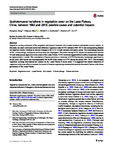Spatiotemporal variations in vegetation cover on the Loess Plateau, China, between 1982 and 2013: possible causes and potential impacts
| dc.contributor.author | Kong, D | |
| dc.contributor.author | Miao, Chiyuan | |
| dc.contributor.author | Borthwick, Alistair | |
| dc.contributor.author | Lei, X | |
| dc.contributor.author | Li, H | |
| dc.date.accessioned | 2021-08-22T16:24:15Z | |
| dc.date.available | 2021-08-22T16:24:15Z | |
| dc.date.issued | 2018-05 | |
| dc.identifier.issn | 0944-1344 | |
| dc.identifier.issn | 1614-7499 | |
| dc.identifier.uri | http://hdl.handle.net/10026.1/17696 | |
| dc.description.abstract |
Vegetation is a key component of the ecosystem and plays an important role in water retention and resistance to soil erosion. In this study, we used a multiyear normalized difference vegetation index (NDVI) dataset (1982-2013) and corresponding datasets for observed climatic variables to analyze changes in the NDVI at both temporal and spatial scales. The relationships between NDVI, climate change, and human activities were also investigated. The annual average NDVI showed an upward trend over the 32-year study period, especially in the center of the Loess Plateau. NDVI variations lagged behind monthly temperature changes by approximately 1 month. The contribution of human activities to variations in NDVI has become increasingly significant in recent years, with human activities responsible for 30.4% of the change in NDVI during the period 2001-2013. The increased vegetation coverage has reduced soil erosion on the Loess Plateau in recent years. It is suggested that natural restoration of vegetation is the most effective measure for control of erosion; engineering measures that promote this should feature in the future governance of the Loess Plateau. | |
| dc.format.extent | 13633-13644 | |
| dc.format.medium | Print-Electronic | |
| dc.language | en | |
| dc.language.iso | eng | |
| dc.publisher | Springer Science and Business Media LLC | |
| dc.subject | Climate change | |
| dc.subject | Human activities | |
| dc.subject | Loess Plateau | |
| dc.subject | Soil erosion | |
| dc.subject | Vegetation cover | |
| dc.subject | China | |
| dc.subject | Climate Change | |
| dc.subject | Ecosystem | |
| dc.subject | Human Activities | |
| dc.subject | Soil | |
| dc.title | Spatiotemporal variations in vegetation cover on the Loess Plateau, China, between 1982 and 2013: possible causes and potential impacts | |
| dc.type | journal-article | |
| dc.type | Journal Article | |
| plymouth.author-url | https://www.ncbi.nlm.nih.gov/pubmed/29500591 | |
| plymouth.issue | 14 | |
| plymouth.volume | 25 | |
| plymouth.publication-status | Published | |
| plymouth.journal | Environmental Science and Pollution Research | |
| dc.identifier.doi | 10.1007/s11356-018-1480-x | |
| plymouth.organisational-group | /Plymouth | |
| plymouth.organisational-group | /Plymouth/Faculty of Science and Engineering | |
| plymouth.organisational-group | /Plymouth/Faculty of Science and Engineering/School of Engineering, Computing and Mathematics | |
| plymouth.organisational-group | /Plymouth/Users by role | |
| plymouth.organisational-group | /Plymouth/Users by role/Academics | |
| dc.publisher.place | Germany | |
| dcterms.dateAccepted | 2018-02-04 | |
| dc.identifier.eissn | 1614-7499 | |
| dc.rights.embargoperiod | Not known | |
| rioxxterms.versionofrecord | 10.1007/s11356-018-1480-x | |
| rioxxterms.licenseref.uri | http://www.rioxx.net/licenses/all-rights-reserved | |
| rioxxterms.licenseref.startdate | 2018-05 | |
| rioxxterms.type | Journal Article/Review |


